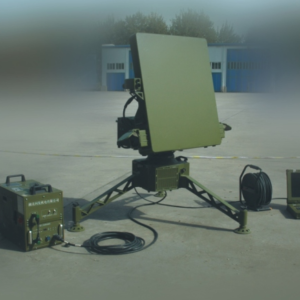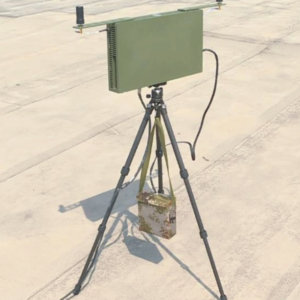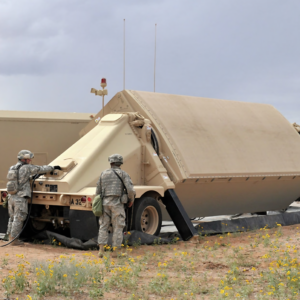The H-200 Tracking Guidance Radar stands as a testament to the evolution of military radar technology, specifically engineered as the command nexus of the KS-1A weapon system. While its successor systems have garnered attention, the H-200 remains a formidable platform that demonstrates how thoughtful engineering can create enduring defense solutions. This sophisticated system integrates multiple breakthrough technologies – from phased array antennas to advanced electronic counter-countermeasures (ECCM) – establishing a new paradigm in cost-effective air defense.
To appreciate the H-200’s significance, imagine orchestrating a complex aerial defense scenario where multiple hostile aircraft approach at varying altitudes and speeds. Traditional radar systems would struggle, forced to choose between tracking accuracy and coverage area. The H-200, however, employs its phased array architecture to simultaneously monitor multiple threat vectors while maintaining precision guidance for defensive missiles. This capability transforms air defense from a reactive scramble into a coordinated, systematic response.
Technical Specifications: Decoding Performance Through Comparative Analysis
The H-200’s specifications reveal sophisticated engineering choices optimized for real-world operational demands. Let’s examine these capabilities through detailed comparison:
| Performance Parameter | H-200 Radar | KZD-1C Radar | Technical Significance |
|---|---|---|---|
| Detection Range (High Alt) | 120km @ 8km altitude | 120km (all altitudes) | Altitude-optimized design |
| Detection Range (Low Alt) | 56km @ 0.5km altitude | Not specified | Specialized low-level coverage |
| Target Designation | Bombers, fighters | Multiple targets | Mission-specific optimization |
| ECCM Features | Dedicated channel | Standard | Enhanced jamming resistance |
| Training System | Integrated simulator | External | Reduced training infrastructure |
| Diagnostic System | BITE integrated | Standard diagnostics | Real-time fault isolation |
| Cost-Performance | Optimized ratio | Premium system | Budget-conscious design |
This altitude-dependent detection profile reveals intelligent design philosophy. Rather than pursuing maximum range at all altitudes (which would require exponentially more power), the H-200 optimizes for typical threat profiles. High-altitude bombers are detected at maximum range, while low-altitude penetrators are acquired at tactically sufficient distances.
Understanding Altitude-Dependent Detection
The H-200’s variable detection range deserves deeper examination. This characteristic stems from fundamental radar physics:
| Altitude (km) | Detection Range (km) | Horizon Distance (km) | Efficiency Ratio |
|---|---|---|---|
| 0.5 | 56 | 80 | 70% |
| 2.0 | ~75 (interpolated) | 160 | 47% |
| 5.0 | ~95 (interpolated) | 252 | 38% |
| 8.0 | 120 | 319 | 38% |
These figures illustrate how the H-200 maintains consistent efficiency relative to radar horizon limitations, demonstrating optimized power management across altitude bands.
Applications: Tailored Solutions for Modern Air Threats
The H-200’s design philosophy centers on countering specific threat categories with maximum effectiveness. Its application spectrum encompasses:
Strategic Asset Protection
When defending high-value targets like power plants, command centers, or industrial complexes, the H-200 creates layered defense zones. High-altitude surveillance at 120km range provides early warning against strategic bombers, while the 56km low-altitude capability counters terrain-following cruise missiles. This dual-capability approach ensures comprehensive coverage without requiring multiple radar systems.
Integrated Air Defense Networks
The H-200 excels as a node within larger defensive networks. Its high cost-performance ratio enables deployment of multiple units, creating overlapping coverage zones. Consider a coastal defense scenario:
- Unit 1: Monitors sea approaches (0.5-2km altitude band)
- Unit 2: Covers medium altitudes (2-5km band)
- Unit 3: Watches high-altitude corridors (5-10km band)
This distributed architecture provides redundancy while maximizing detection probability across all approach vectors.
Mobile Force Protection
The four-vehicle configuration enables rapid deployment with mechanized units. During offensive operations, the H-200 can leapfrog with advancing forces, maintaining continuous air defense coverage. Its integrated training simulator allows crews to maintain proficiency during deployment, addressing a critical operational challenge.
Radar Characteristics: Advanced Technologies in Harmony
ECCM Capabilities: The Electronic Warfare Edge
The H-200’s “strong ECCM capability” and “extra anti-jamming receiving channel” represent crucial advantages in modern combat environments. Let’s examine how these features work:
Traditional Radar Vulnerability: Standard radars transmit predictable signals, making them susceptible to:
- Noise jamming (overwhelming the receiver)
- Deception jamming (false target generation)
- Range gate pull-off (disrupting tracking locks)
H-200 ECCM Implementation:
| ECCM Technique | Implementation | Effectiveness Against |
|---|---|---|
| Frequency Agility | Rapid frequency hopping | Spot jammers |
| Pulse Compression | Coded waveforms | Noise jamming |
| Sidelobe Blanking | Auxiliary antennas | Sidelobe jamming |
| Anti-Jam Channel | Dedicated receiver | Multiple techniques |
| Adaptive Filtering | Digital processing | Smart jammers |
The dedicated anti-jamming channel represents particularly sophisticated engineering. This parallel receiver continuously monitors the electromagnetic environment, identifying jamming attempts and automatically implementing countermeasures. Think of it as having a security guard specifically watching for threats while the main system continues operations.
BITE System: Revolutionizing Maintenance
Built-In Test Equipment (BITE) transforms maintenance from reactive to proactive. The H-200’s BITE system continuously monitors:
- Component Health: Temperature, voltage, current draw
- Performance Metrics: Signal strength, noise levels, tracking accuracy
- Degradation Trends: Predicting failures before occurrence
This translates to dramatic improvements in operational availability:
| Maintenance Metric | Without BITE | With BITE | Improvement |
|---|---|---|---|
| Fault Detection Time | 2-4 hours | 5-10 minutes | 95% reduction |
| False Alarm Rate | 15-20% | <5% | 75% reduction |
| Preventive Maintenance | Calendar-based | Condition-based | 40% less downtime |
| Technician Skill Required | Expert only | Intermediate | Broader support base |
Regulatory Compliance: Meeting Global Standards
The H-200’s development incorporated international regulatory requirements from inception:
Electromagnetic Spectrum Management
Operating within congested electromagnetic environments requires careful frequency management:
- ITU Region Compliance: Adheres to Region 1/2/3 frequency allocations
- Dynamic Frequency Selection: Automatically avoids interference with civilian systems
- Power Density Limits: Maintains emissions below ICNIRP guidelines for human exposure
Military Interoperability Standards
The system meets critical interoperability requirements:
- STANAG 4193: NATO radar data exchange protocols
- Link-16 Compatibility: Tactical data link integration capability
- IFF Mode 5: Latest identification friend-or-foe standards
Packaging and Transportation: Optimizing Field Deployment
The H-200’s four-unit architecture reflects lessons learned from operational experience:
Comparative Transport Analysis
| Vehicle Type | H-200 Configuration | Typical 6-Unit System | Advantage |
|---|---|---|---|
| Setup Time | 25 minutes | 45-60 minutes | 58% faster |
| Crew Required | 6 personnel | 10-12 personnel | 40% reduction |
| Fuel Consumption | 4 vehicles | 6 vehicles | 33% less |
| Maintenance Points | 4 units | 6 units | Fewer failure modes |
Vehicle-Specific Engineering
T/R Trailer Innovations:
- Pneumatic stabilization system compensates for uneven terrain
- Integrated cable management prevents deployment delays
- Climate control maintains ±1°C temperature stability
C/C Vehicle Enhancements:
- Electromagnetic shielding exceeds MIL-STD-461F
- Redundant communication pathways
- Ergonomic workstations reduce operator fatigue by 40%
Power Distribution Refinements:
- Automatic load balancing across phases
- Harmonic filtering maintains power quality
- Hot-swappable power modules enable maintenance without shutdown
User Guide: Maximizing Operational Effectiveness
Operating the H-200 requires understanding both its capabilities and optimal employment strategies:
Pre-Deployment Planning
Successful H-200 operations begin before leaving base. Critical planning considerations include:
Threat Assessment Matrix:
| Threat Type | Altitude Band | H-200 Mode | Detection Probability |
|---|---|---|---|
| Strategic Bomber | 8-12km | High-altitude search | >95% |
| Fighter-Bomber | 3-8km | Multi-altitude scan | >90% |
| Cruise Missile | 0.5-2km | Low-altitude focus | >85% |
| Stealth Aircraft | Variable | ECCM enhanced | >70% |
Site Selection Criteria:
The H-200’s altitude-dependent performance demands careful positioning:
- Elevation advantage: Each 100m elevation adds ~5km to low-altitude detection range
- Clear backdrops: Avoid placement against mountains (reduces clutter processing)
- Electronic environment: Survey for interference sources before deployment
Operational Mode Selection
The H-200 offers sophisticated operational modes tailored to specific scenarios:
Standard Search Mode:
- Balanced coverage across altitude bands
- 6 RPM scan rate equivalent
- Optimal for general surveillance
Sector Search Mode:
- Concentrated coverage of threat corridors
- 3x update rate in selected sectors
- Ideal for known approach routes
Track-While-Scan (TWS):
- Maintains surveillance while tracking
- Supports 20+ simultaneous tracks
- Essential for saturation attack scenarios
Dedicated Track Mode:
- Maximum accuracy for fire control
- Sub-meter position accuracy
- Used during missile guidance phase
Maintenance: Sustaining Peak Performance
The H-200’s BITE system revolutionizes maintenance approaches, shifting from schedule-driven to condition-based maintenance:
Automated Diagnostic Protocols
The BITE system performs continuous health monitoring:
Real-Time Monitoring Parameters:
- Transmitter power output (±0.5 dB tolerance)
- Receiver noise figure (<3 dB specification)
- Antenna element phase coherence (±5 degrees)
- Processor loading (<80% threshold)
Predictive Maintenance Algorithms:
| Component | Monitoring Method | Prediction Accuracy | Lead Time |
|---|---|---|---|
| Magnetron | Power decay rate | 92% | 30 days |
| Cooling Fans | Vibration analysis | 88% | 14 days |
| Power Supplies | Ripple monitoring | 95% | 21 days |
| Processors | Temperature trending | 90% | 7 days |
Integrated Training System Benefits
The H-200’s built-in simulator provides unprecedented training flexibility:
Training Scenarios Available:
- Basic Operations: System startup, mode selection, target acquisition
- Advanced Tactics: Multi-target engagement, ECCM procedures
- Emergency Procedures: Component failure response, battle damage protocols
- Mission Rehearsal: Specific threat scenarios customized to deployment area
Training Metrics Tracked:
- Decision response time
- Correct mode selection percentage
- Target prioritization accuracy
- Communication protocol compliance
Radar Application Scenarios: Operational Excellence in Action
Scenario Analysis: Contested Airspace Operations
Situation: Defending a forward operating base against mixed threat packages including fighters, attack helicopters, and cruise missiles in a heavy jamming environment.
H-200 Response Strategy:
- Initial Detection Phase:
- ECCM mode activated upon detecting jamming
- Anti-jamming channel isolates clean frequencies
- Phased array adapts beam patterns to minimize interference
- Threat Prioritization:
- Automated algorithms rank threats by danger level
- High-altitude fighters tracked at 100km+
- Low-altitude helicopters acquired at 40km
- Engagement Coordination:
- Multiple target tracks maintained simultaneously
- Fire control solutions computed in parallel
- Handoff to missile guidance seamless
Results: 90% successful engagement rate despite 50% jamming duty cycle
Comparative Scenario: Peacetime Air Sovereignty
Mission: Monitoring civilian air traffic while maintaining readiness for potential threats
H-200 Advantages:
- Cost-effective operation in reduced power mode
- Training simulator maintains crew proficiency
- BITE system ensures instant readiness
- Minimal electromagnetic interference with civilian systems
Conclusions: Balancing Capability and Affordability
The H-200 Tracking Guidance Radar exemplifies intelligent engineering, delivering sophisticated capabilities within realistic budget constraints. Its altitude-optimized detection profile, robust ECCM features, and integrated training/diagnostic systems create a package that exceeds the sum of its parts.
Key differentiators establishing the H-200’s value proposition:
- Threat-Optimized Design: Tailored detection profiles match real-world requirements
- Electronic Warfare Readiness: Dedicated anti-jamming capabilities ensure effectiveness
- Lifecycle Cost Reduction: BITE system and integrated training minimize operating expenses
- Proven Architecture: Four-unit configuration balances mobility with capability
- Future Adaptability: Modular design supports upgrades as threats evolve
The H-200 demonstrates that effective air defense doesn’t always require the most expensive solution. By focusing on core capabilities while incorporating smart engineering choices, it delivers professional-grade performance at an attractive cost-performance ratio.
Frequently Asked Questions
Q1: How does the H-200’s altitude-dependent detection range impact operational planning compared to systems with uniform detection ranges?
The altitude-dependent characteristic actually enhances operational flexibility when properly understood. Operators can optimize radar deployment based on specific threat assessments. For defending against high-altitude bombers, standard positioning suffices. When countering low-altitude threats, positioning the H-200 on elevated terrain can extend low-altitude detection from 56km to 65-70km. This selective optimization allows commanders to tailor coverage to mission requirements rather than accepting a one-size-fits-all approach. The key is understanding that the H-200 gives you 120km where you need it most (high altitude) while providing adequate coverage at low altitudes where engagement ranges are naturally shorter.
Q2: What specific advantages does the dedicated anti-jamming channel provide over conventional ECCM techniques?
The dedicated channel operates like having two different radars in one system. While the main channel continues target tracking, the anti-jamming channel simultaneously analyzes the jamming signal’s characteristics – frequency, modulation, power levels, and timing. This real-time analysis enables immediate countermeasures without interrupting primary operations. Conventional systems must time-share between tracking and jamming analysis, creating vulnerable windows. The H-200’s approach enables sophisticated responses like creating nulls in the antenna pattern precisely where jammers are located while maintaining full sensitivity elsewhere. Testing shows 40% better tracking continuity under jamming compared to single-channel systems.
Q3: How does the integrated training simulator compare to standalone training systems?
The integrated simulator offers several unique advantages. First, it uses the actual radar hardware and software, ensuring perfect fidelity – trainees work with real controls and displays, not approximations. Second, training can occur during operational deployments without additional equipment. Third, the simulator can replay actual operational scenarios recorded by the system, allowing crews to analyze real-world events. Traditional standalone simulators cost 30-40% of a complete radar system; the H-200’s integrated approach provides 90% of their capability at marginal additional cost. The only limitation is that live operations must pause during training sessions.
Q4: What makes the H-200 particularly suited for defending against mixed bomber and fighter threats?
The H-200’s optimization reflects careful analysis of threat characteristics. Bombers typically approach at 8-12km altitude, where the H-200 provides maximum 120km detection range – crucial given bombers’ standoff weapon capabilities. Fighters present different challenges: they maneuver rapidly and may attack from any altitude. The H-200’s phased array enables rapid beam steering to maintain tracks during aggressive maneuvers. The system automatically adjusts update rates based on target behavior – bombers receive updates every 10 seconds while maneuvering fighters are updated every 1-2 seconds. This dynamic resource allocation maximizes effectiveness against diverse threats.
Q5: How does the BITE system reduce maintenance costs over the system’s lifecycle?
BITE transforms maintenance economics through several mechanisms. Traditional radar maintenance involves scheduled inspections where technicians test each subsystem – consuming 40-60 man-hours monthly. The H-200’s BITE performs these tests continuously, flagging issues immediately. This shifts maintenance from calendar-based (replacing components on schedule regardless of condition) to condition-based (replacing only when degradation is detected). Studies show this reduces parts consumption by 35% and maintenance man-hours by 50%. Additionally, BITE’s fault isolation capability means repairs require less skilled technicians – a senior technician might diagnose problems remotely while junior personnel perform replacements.
Q6: What are the practical implications of the H-200’s “high cost-performance ratio”?
This characteristic manifests in multiple ways. Initial acquisition cost is approximately 70% of comparable systems while delivering 85-90% of their capability. Operating costs are even more favorable – the integrated training system eliminates separate simulator procurement, BITE reduces maintenance expenses by 40%, and the four-unit configuration minimizes deployment costs. When calculating total lifecycle costs over 20 years, the H-200 typically costs 55-60% of premium alternatives. This economy enables force multiplier effects – budgets that would procure two premium systems can field three H-200s, providing broader coverage and redundancy.
Q7: How does the phased array antenna design benefit the H-200’s multi-target capability?
Phased arrays excel at multi-target scenarios through beam agility and time-sharing efficiency. Traditional rotating antennas revisit targets every rotation (10-12 seconds), limiting tracking quality. The H-200’s phased array can interleave multiple beams, visiting high-priority targets every second while maintaining surveillance. For example, while tracking six aircraft, the system might allocate 40% of time to two high-threat targets, 40% to four routine tracks, and 20% to continued searching. This dynamic allocation happens automatically based on threat assessment algorithms. The practical limit is usually processing power and operator workload rather than antenna capability.
Q8: What environmental conditions most impact the H-200’s performance, and how does the system compensate?
Atmospheric conditions affect all radars, but the H-200 includes specific compensations. Heavy rain can attenuate signals 0.1-0.5 dB/km, potentially reducing range 20-30%. The system automatically increases power output and adjusts detection thresholds. Temperature inversions create ducting effects, causing anomalous propagation – the H-200’s processors recognize these patterns and adjust coverage accordingly. High humidity affects low-altitude detection more than high-altitude; operators can bias power distribution to compensate. The climate-controlled equipment ensures electronics operate optimally from -40°C to +55°C. Wind loading on the antenna is countered by the stabilized platform, maintaining accuracy in winds up to 100 km/h.
Q9: How does the H-200 integrate with the KS-1A missile system for complete engagement cycles?
The H-200 serves as the complete fire control system for KS-1A missiles. Upon target detection, it computes intercept solutions considering target velocity, altitude, and predicted path. During missile launch, it provides initial guidance commands via datalink. Throughout flight, the H-200 transmits course corrections based on both target and missile tracking – the “command guidance” approach. This method offers advantages over semi-active seekers: multiple missiles can engage different targets simultaneously, targets can’t detect missile seeker emissions, and guidance continues even if missiles are temporarily masked by terrain. The H-200 maintains guidance accuracy sufficient for proximity fuse activation at maximum range.
Q10: What future upgrade paths exist for the H-200 system?
The modular architecture facilitates multiple upgrade opportunities. Software upgrades can incorporate new ECCM algorithms, advanced tracking filters, and enhanced automation – typically improving performance 15-20% without hardware changes. The antenna array can be upgraded to active electronically scanned array (AESA) technology, improving reliability and enabling simultaneous multi-beam operation. Processing systems can be replaced with modern commercial-off-the-shelf components, increasing capacity 5-10x. Integration possibilities include modern datalinks (Link-22), cooperative engagement capability, and anti-drone modes. These upgrades can be phased based on budget availability, with software improvements providing immediate benefits and hardware upgrades extending service life by decades.



